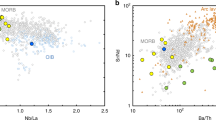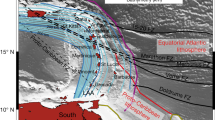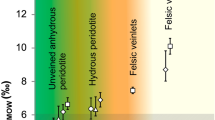Abstract
Subduction modifies the cycling of Earth’s volatile elements. Fluid-rich sediments and hydrated oceanic lithosphere enter the convecting mantle at subduction zones. Some of the sediments and volatile components are released from the subducting slab, promote mantle melting and are returned to the surface by volcanism. The remainder continue into the deeper mantle. Quantification of the fate of these volatiles requires an understanding of both the nature and timing of fluid release and mantle melting1. Here we analyse the trace element and isotopic geochemistry of fragments of upper mantle rocks that were transported to the surface by volcanic eruptions above the Batan Island subduction zone, Philippines. We find that the mantle fragments exhibit extreme disequilibrium between their U–Th–Ra isotopic ratios, which we interpret to result from the interaction of wet sediment melts and slab-derived fluids with rocks in the overlying mantle wedge. We infer that wet sediments were delivered from the slab to the mantle wedge between 8,000 and 10,000 years ago, whereas aqueous fluids were delivered separately much later. We estimate that about 625 ppm of water is retained in the wedge. A significant volume of water could therefore be delivered to the mantle transition zone at the base of the upper mantle, or even to the deeper mantle.
This is a preview of subscription content, access via your institution
Access options
Subscribe to this journal
Receive 12 print issues and online access
$259.00 per year
only $21.58 per issue
Buy this article
- Purchase on Springer Link
- Instant access to full article PDF
Prices may be subject to local taxes which are calculated during checkout




Similar content being viewed by others
References
Plank, T., Cooper, L. B. & Manning, C. E. Emerging geothermometers for estimating slab surface temperatures. Nature Geosci. 16, 611–615 (2009).
Turner, S., Bourdon, B. & Gill, J. Insights into magma genesis at convergent margins from U-series isotopes. Rev. Mineral. Geochem. 52, 255–315 (2003).
Gill, J. B., Morris, J. D. & Johnson, R. W. Timescale for producing the geochemical signature of island arc magmas: U–Th–Po and Be–B systematics in Recent Papua New Guinea lavas. Geochim. Cosmochim. Acta 57, 4269–4283 (1993).
Reagan, M. K., Morris, J. D., Herrstrom, E. A. & Murrell, M. T. Uranium series and beryllium isotope evidence for an extended history of subduction modification of the mantle below Nicaragua. Geochim. Cosmochim. Acta 58, 4199–4212 (1994).
Elliott, T., Plank, T., Zindler, A., White, W. & Bourdon, B. Element transport from slab to volcanic front at the Mariana arc. J. Geophys. Res. 102, 14991–15019 (1997).
Turner, S., Evans, P. & Hawkesworth, C. Ultra-fast source-to-surface movement of melt at island arcs from 226Ra–230Th systematics. Science 292, 1363–1366 (2001).
Feineman, M. D. & DePaolo, D. J. Steady-state 226Ra/230Th disequilibrium in mantle minerals: Implications for melt transport rates in island arcs. Earth Planet. Sci. Lett. 215, 339–355 (2003).
Villemant, B., Boudon, G. & Komorowski, J. C. U-series disequilibrium in arc magmas induced by water-magma interaction. Earth Planet. Sci. Lett. 140, 259–267 (1996).
Dufek, J. & Cooper, K. M. 226Ra/230Th excess generated in the lower crust: Implications for magma transport and storage time scales. Geology 33, 833–836 (2005).
Huang, F., Gao, L. & Lundstrom, C. C. The effect of assimilation, fractional crystallisation, and ageing on U-series disequilibria in subduction zone lavas. Geochim. Cosmochim. Acta 72, 4136–4145 (2008).
Maury, R. C., Defant, M. J. & Joron, J. L. Metasomatism of the sub-arc mantle inferred from trace elements in Philippine xenoliths. Nature 360, 661–663 (1992).
Vidal, Ph., Dupuy, C., Maury, R. & Richard, M. Mantle metasomatism above subduction zones: Trace-element and radiogenic isotope characteristics of peridotite xenoliths from Batan Island (Philippines). Geology 17, 1115–1118 (1989).
Schiano, P. et al. Hydrous, silica-rich melts in the sub-arc mantle and their relationships with erupted arc lavas. Nature 377, 595–600 (1995).
Sajona, F. G. et al. Slab melt as metasomatic agent in island arc magma mantle sources, Negros and Batan (Philippines). Island Arc 9, 472–486 (2000).
Eiler, J. M., Schiano, P., Valley, J. W., Kita, N. T. & Stolper, E. M. Oxygen-isotope and trace element constraints on the origins of silica-rich melts in the subarc mantle. Geochem. Geophys. Geosyst. 8, Q09012 (2007).
Arai, S., Takada, S., Ashi, K. M. & Kida, M. Petrology of peridotite xenoliths from Iraya volcano, Philippines, and its implication for dynamic mantle-wedge processes. J. Petrol. 45, 369–389 (2004).
Syracuse, E. M., van Keken, P. E. & Abers, G. A. The global range of subduction zone thermal models. Phys. Earth Planet. Inter. 183, 73–90 (2010).
Hawkesworth, C. J., Turner, S. P., McDermott, F., Peate, D. W. & van Calsteren, P. U–Th isotopes in arc magmas: Implications for element transfer from the subducted crust. Science 276, 551–555 (1997).
McDermott, F., Defant, M. J., Hawkesworth, C. J., Maury, R. C. & Joron, J. L. Isotope and trace element evidence for three component mixing in the genesis of the North Luzon arc lavas (Philippines). Contrib. Mineral. Petrol. 113, 9–23 (1993).
DuFrane, S. A., Asmerom, Y., Musaka, S. B., Morris, J. D. & Dreyer, B. M. Subduction and melting processes inferred from U-series, Sr–Nd–Pb isotope, and trace element data, Bicol and Bataan arcs, Philippines. Geochim. Cosmochim. Acta 70, 3401–3420 (2006).
Yaxley, G. M. & Kamenetsky, V. In situ origin for glass in mantle xenoliths from southeastern Australia: Insights from trace element compositions of glasses and metasomatic phases. Earth Planet. Sci. Lett. 172, 97–109 (1999).
Handley, H. K., Turner, S., Macpherson, C., Gertisser, R. & Davidson, J. P. Hf–Nd isotope and trace element constraints on subduction zone inputs at island arcs: Limitations of Hf anomalies as sediment input indicators. Earth Planet. Sci. Lett. 304, 212–223 (2011).
Mierdel, K., Keppler, H., Smyth, J. R. & Langenhorst, F. Water solubility in aluminous orthopyroxene and the origin of Earth’s asthenosphere. Science 315, 364–368 (2007).
Richard, M. et al. Geology of Mt. Iraya volcano and Batan island, northern Philippines. Philipp. Bull. Volcanol. 3, 1–27 (1986).
Bell, D. R., Ihinger, P. D. & Rossman, G. R. Quantitative analysis of trace OH in garnet and pyroxenes. Am. Mineral. 80, 465–474 (1995).
Hauri, E. H., Gaetani, G. A. & Green, T. H. Partitioning of water during melting of the Earth’s upper mantle at H2O-undersaturated conditions. Earth Planet. Sci. Lett. 248, 715–734 (2006).
Beier, C., Turner, S., Sinton, J. & Gill, J. Influence of subducted components on back-arc melting dynamics in the Manus Basin. Geochem. Geophys. Geosyst. 11, Q0AC03 (2010).
Engdahl, E. R., van der Hilst, R. & Buland, R. Global teleseismic earthquake relocation with improved travel times and procedures for depth determination. Bull. Seismol. Soc. Am. 88, 722–743 (1998).
Green, D. H., Hibberson, W. O., Kovacs, I. & Rosenthal, A. Water and its influence on the lithosphere–asthenosphere boundary. Nature 467, 448–452 (2010).
Williams, R. W. & Gill, J. B. Effects of partial melting on the uranium decay series. Geochim. Cosmochim. Acta 53, 1607–1619 (1989).
Acknowledgements
We wish to thank the participants of the 2010 State of the Arc meeting on Santorini for their inspiration and discussions. We are grateful to I. Smith for the XRF analyses and to P. Wieland for analytical assistance at Macquarie. H. O’Neill first encouraged us to look at water and K. Grant helped with the initial FTIR scans. The original manuscript was greatly improved by comments from F. Huang. This work was funded by an Australian Research Council Professorial Fellowship (DP0988658) to S.T., a New Zealand Foundation for Research, Science and Technology post-doctoral Fellowship to M.T. and a National Science Foundation grant (OCE 0841075) to P.v.K. It used instrumentation funded by ARC LIEF and DEST Systemic Infrastructure Grants, Macquarie University and industry.
Author information
Authors and Affiliations
Contributions
S.T. planned the project, carried out preliminary analyses and wrote the manuscript. J.C. carried out the majority of the U-series analyses. M.T. performed the FTIR work. P.v.K. carried out the geodynamic calculations. R.M. and G.P. provided the samples. M.S. produced the seismic images.
Corresponding author
Ethics declarations
Competing interests
The authors declare no competing financial interests.
Supplementary information
Supplementary Information
Supplementary Information (PDF 299 kb)
Rights and permissions
About this article
Cite this article
Turner, S., Caulfield, J., Turner, M. et al. Recent contribution of sediments and fluids to the mantle’s volatile budget. Nature Geosci 5, 50–54 (2012). https://doi.org/10.1038/ngeo1325
Received:
Accepted:
Published:
Issue Date:
DOI: https://doi.org/10.1038/ngeo1325
This article is cited by
-
An introductory review of the thermal structure of subduction zones: III—Comparison between models and observations
Progress in Earth and Planetary Science (2023)
-
Thermal Equation of State of Natural F-Rich Topaz up to 29 GPa and 750 K
Journal of Earth Science (2023)
-
Geochemistry and zircon U–Pb ages of the Paleoproterozoic ultramafic rocks of the Mbi Valley, Boali area, Central African Republic
Acta Geochimica (2022)
-
Rapid transition from MORB-type to SSZ-type oceanic crust generation following subduction initiation: insights from the mafic dikes and metamorphic soles in the Pozantı-Karsantı ophiolite, SE Turkey
Contributions to Mineralogy and Petrology (2021)
-
Geochronology, petrogenesis, and tectonic implications of Permian felsic rocks of the Central Great Xing’an Range, NE China
International Journal of Earth Sciences (2019)



